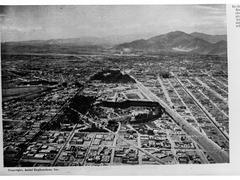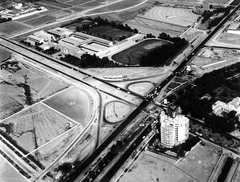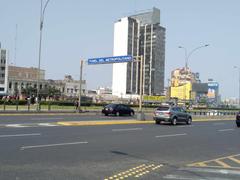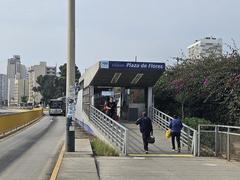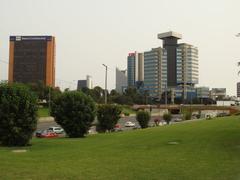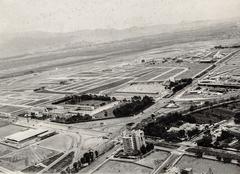Paseo De La República, Lima, Peru: Visiting Hours, Tickets, and Travel Guide
Date: 14/06/2025
Introduction
Paseo de la República, officially named Vía Expresa Luis Fernán Bedoya Reyes, is one of Lima’s most prominent urban thoroughfares. Spanning approximately 9 kilometers and traversing the heart of the Peruvian capital, this expressway is a showcase of Lima’s urban evolution, cultural heritage, and ongoing modernization. Originally conceived to connect the historic city center with the expanding southern districts, Paseo de la República has become much more than a transit route—it is a symbol of the city’s dynamism, a hub for public transportation, and a gateway to many of Lima’s key attractions (La República, 2024).
This guide provides a comprehensive overview of Paseo de la República’s history, cultural significance, practical visitor information, and travel tips, as well as details on nearby attractions and current urban developments.
Table of Contents
- Historical Overview
- Route Overview and Key Districts
- Landmarks and Nearby Attractions
- Visitor Information: Hours, Tickets, and Accessibility
- Transit Options and Safety
- Art, Culture, and Symbolism
- Recent Developments and Future Plans
- Frequently Asked Questions (FAQ)
- Summary and Recommendations
- References
Historical Overview
Origins and Development
Paseo de la República was first envisioned in the early 20th century, with the aim of linking Lima’s historic core to its southern neighborhoods. It began as a tree-lined boulevard, reflecting European urban design influences. In the 1960s, facing rapid population growth and mounting traffic congestion, the avenue was transformed into a sunken expressway—“El Zanjón”—under the leadership of Mayor Luis Bedoya Reyes (Wikipedia). This pioneering infrastructure was the first of its kind in Peru and among the earliest in Latin America, marking a significant milestone in the city’s modernization.
Urban and Social Impact
The expressway played a crucial role in the expansion of Lima, making daily commutes between the city center and districts like Miraflores, Barranco, and Chorrillos far more efficient. However, its construction also involved the expropriation of properties and the creation of physical barriers between neighborhoods, sparking debates about urban planning and social cohesion (Ciudad+).
Route Overview and Key Districts
Paseo de la República stretches from the Edificio Rímac in the historic Cercado de Lima southwards through a series of diverse districts:
- Cercado de Lima (Historic Center): Home to colonial-era landmarks and government buildings, with easy access to cultural sites like Parque de la Exposición.
- Lince: A residential and commercial hub, known for its proximity to parks and shopping.
- La Victoria: Bustling with markets and sports venues; subject to ongoing infrastructure improvements.
- San Isidro: Lima’s financial district, featuring modern skyscrapers, embassies, and luxury hotels.
- Surquillo: Renowned for its traditional markets and local cuisine.
- Miraflores: Popular with tourists for its parks, shopping, nightlife, and coastal views.
- Barranco: The bohemian district, celebrated for its vibrant art scene and relaxed atmosphere.
- (Planned) Chorrillos and San Juan de Miraflores: Future extensions aim to connect these southern districts, further enhancing citywide mobility (OpenJICAReport).
Landmarks and Nearby Attractions
Major attractions along or near the avenue include:
- Parque de la Exposición: Historic park with museums and gardens (CuscoPeru.com).
- Parque de la Reserva: Home to the Magic Water Circuit, a spectacular illuminated fountain show (Stadium Guide).
- Estadio Nacional: The national stadium, venue for major sports and events.
- Larcomar: Cliffside shopping and entertainment center in Miraflores.
- Puente Villena Rey: Offers panoramic views of the Pacific Ocean.
Cultural and historical sites in the vicinity include the Centro Histórico, Plaza de Armas, and the Miraflores Boardwalk. Markets like Gamarra (La Victoria) and Polvos Azules offer unique shopping experiences.
Visitor Information: Hours, Tickets, and Accessibility
Visiting Hours
- Paseo de la República: Open 24/7, as it is a main urban corridor.
- Public Parks and Attractions: Typically open during daylight hours; the Magic Water Circuit operates from 6:00 PM to 11:30 PM.
Tickets and Tours
- Expressway Access: Free; no tickets required.
- Metropolitano BRT: Tickets are available at stations via vending machines or ticket booths. Prepaid cards can be purchased for convenience.
- Attractions: Some, like the Magic Water Circuit and museums, charge admission—check official sites for current prices.
- Guided Tours: Walking, cycling, and city tours covering adjacent districts and attractions are widely available.
Accessibility
- Metropolitano Stations: Most are equipped with elevators and ramps.
- Sidewalks and Pedestrian Bridges: Generally accessible, though some older areas may present challenges.
- Wheelchair Users: The Metropolitano BRT is the most reliable accessible transit option.
Transit Options and Safety
- Metropolitano Bus Rapid Transit (BRT): Fastest and most efficient way to traverse the avenue, with frequent departures and accessible stations.
- Surface Buses and Taxis: Widely available; always use official taxis or rideshare apps for safety.
- Walking and Cycling: Pedestrian bridges and adjacent avenues are walkable, especially near parks and cultural sites. Cycling is possible but limited to certain areas.
- Traffic and Safety: Always use designated crossings and pedestrian bridges. Avoid isolated areas after dark, particularly east of Estadio Nacional.
Art, Culture, and Symbolism
Paseo de la República embodies Lima’s civic and cultural identity. The embankments feature gardens and floral displays, while large murals and public art adorn walls and overpasses. Key artworks include a restored mural by Ricardo Wiesse and, historically, works by Fernando de Szyszlo (Wikipedia). The avenue is also a stage for public events, parades, and political demonstrations, reflecting its significance in the city’s collective life.
Recent Developments and Future Plans
- Infrastructure Upgrades: Major renovations in 2024–2025 improved road surfaces, safety barriers, signage, and landscaping (La República, 2024).
- Metropolitano Expansion: Ongoing projects aim to extend BRT services further south.
- Urban Challenges: Efforts continue to balance the need for improved connectivity with the preservation of green spaces and community facilities (Ciudad+).
Frequently Asked Questions (FAQ)
Q: Is Paseo de la República a pedestrian-friendly tourist attraction?
A: It is an expressway, not a pedestrian promenade, but adjacent avenues, parks, and pedestrian bridges offer walkable areas.
Q: Do I need a ticket to access Paseo de la República?
A: No, the avenue is free and open to the public.
Q: How do I get to the main attractions along the avenue?
A: Use the Metropolitano BRT for quick, safe, and accessible transit.
Q: What are the best times to visit?
A: Early mornings or late afternoons are ideal to avoid traffic; evenings are popular for illuminated attractions.
Q: Is it safe to visit at night?
A: Main districts are generally safe, but exercise caution in less busy areas and use official transit at night.
Summary and Recommendations
Paseo de la República stands as a vital artery interweaving Lima’s history, culture, and modern urban life. Its transformation from a peripheral boulevard to a state-of-the-art expressway is emblematic of the city’s resilience and adaptability. The integration of the Metropolitano BRT and recent urban improvements have enhanced accessibility and safety for both residents and visitors (La República, 2024).
For the most rewarding experience:
- Use the Metropolitano for efficient travel.
- Visit during daylight hours for sightseeing and safety.
- Explore nearby attractions like the Magic Water Circuit, Parque de la Exposición, and Barranco’s artistic streets.
- Stay informed about ongoing projects and events through local resources or city apps.
To plan your visit, consider downloading the Audiala app for real-time updates, interactive maps, and curated Lima guides.
